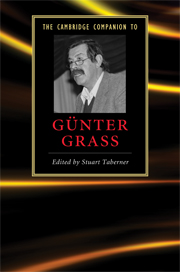Book contents
- Frontmatter
- Introduction
- 1 Biography as politics
- 2 Günter Grass’s political rhetoric
- 3 The exploratory fictions of Günter Grass
- 4 Günter Grass and magical realism
- 5 Günter Grass’s ‘Danzig Quintet’
- 6 Günter Grass and gender
- 7 Authorial construction in From the Diary of a Snail and The Meeting at Telgte
- 8 Günter Grass’s apocalyptic visions
- 9 Günter Grass and German unification
- 10 Günter Grass’s Peeling the Onion
- 11 Günter Grass as poet
- 12 Günter Grass and art
- 13 Günter Grass as dramatist
- 14 Film adaptations of Günter Grass’s prose work
- 15 Günter Grass and his contemporaries in East and West
- Guide to further reading
- Index
14 - Film adaptations of Günter Grass’s prose work
Published online by Cambridge University Press: 28 January 2010
- Frontmatter
- Introduction
- 1 Biography as politics
- 2 Günter Grass’s political rhetoric
- 3 The exploratory fictions of Günter Grass
- 4 Günter Grass and magical realism
- 5 Günter Grass’s ‘Danzig Quintet’
- 6 Günter Grass and gender
- 7 Authorial construction in From the Diary of a Snail and The Meeting at Telgte
- 8 Günter Grass’s apocalyptic visions
- 9 Günter Grass and German unification
- 10 Günter Grass’s Peeling the Onion
- 11 Günter Grass as poet
- 12 Günter Grass and art
- 13 Günter Grass as dramatist
- 14 Film adaptations of Günter Grass’s prose work
- 15 Günter Grass and his contemporaries in East and West
- Guide to further reading
- Index
Summary
Grass's output documents not just a history of the German language, its restitution and reinvigoration in The Tin Drum (1959) after its corruption by National Socialism, but also a history of film. Though recent scholarship has partially salvaged the 1950s as a decade not limited to escapist Heimat films, that is, films playing in 'innocent' country settings and characterised by their sentimental tone and simplistic morality, the Nazi years created a major hiatus between the glories of Weimar cinema and the beginnings of the New German Cinema around the mid-1960s. The 1970s then saw a number of film adaptations of literary texts, the two most famous being Rainer Werner Fassbinder's film version of nineteenth-century novelist Theodor Fontane's Effi Briest and Volker Schlondorff's The Tin Drum. The issue is still more complex today, when leading figures in German literature and film (Emine Sevgi Özdamar and Fatih Akin, respectively) come from ethnically mixed Turkish-German backgrounds. This chapter cannot do justice to the broader issue of film adaptations of literature, which in Germany have long been caught up in debates surrounding 'high' and 'low' art. But the case of Grass is very different to that of another frequently filmed author, Thomas Mann. The challenge posed to film by Mann's works resides in their verbal irony, particularly in the abstract nouns and Classical allusions. By contrast, Grass's larger works sprawl across linguistic canvases that are equally intricate, but which also combine levels of reality and time (for example, the context of magical realism, as discussed elsewhere in this volume) that stretch concrete images in realistic film traditions.
- Type
- Chapter
- Information
- The Cambridge Companion to Günter Grass , pp. 193 - 208Publisher: Cambridge University PressPrint publication year: 2009



